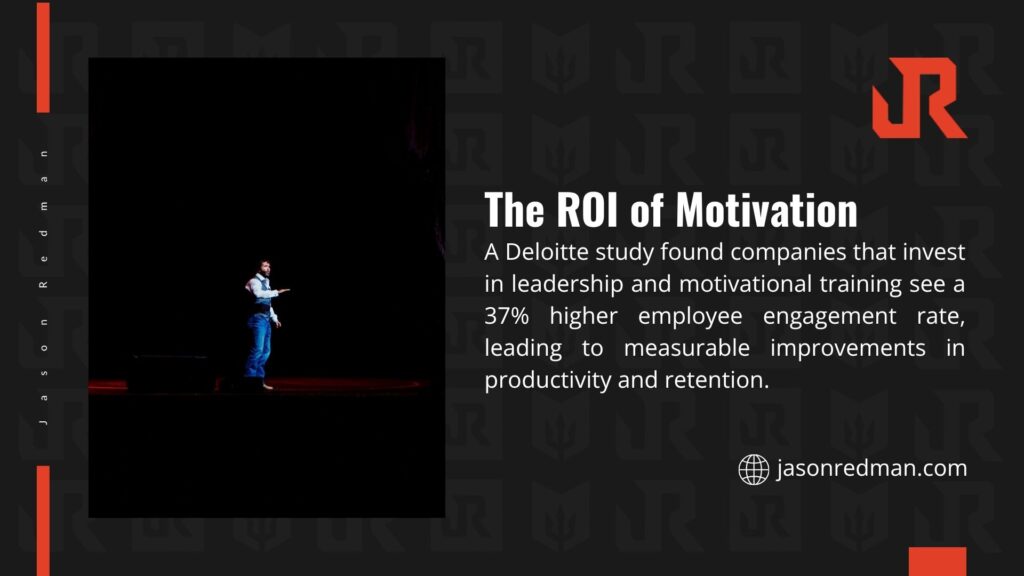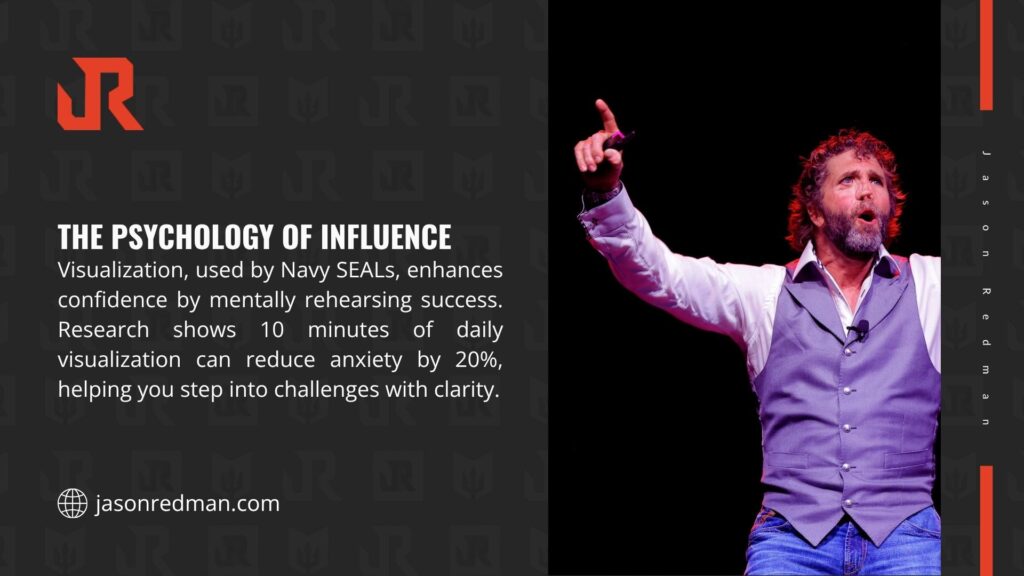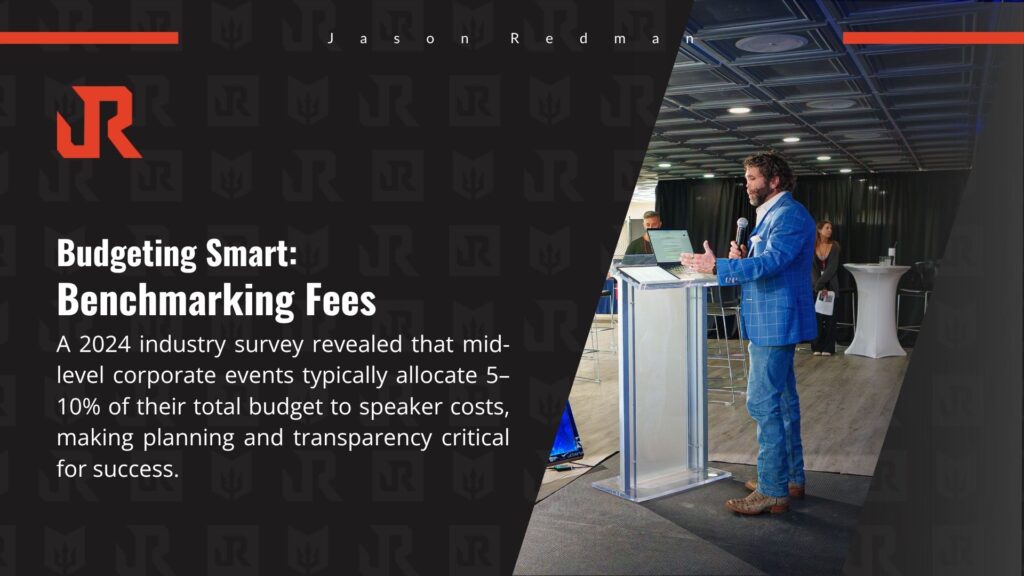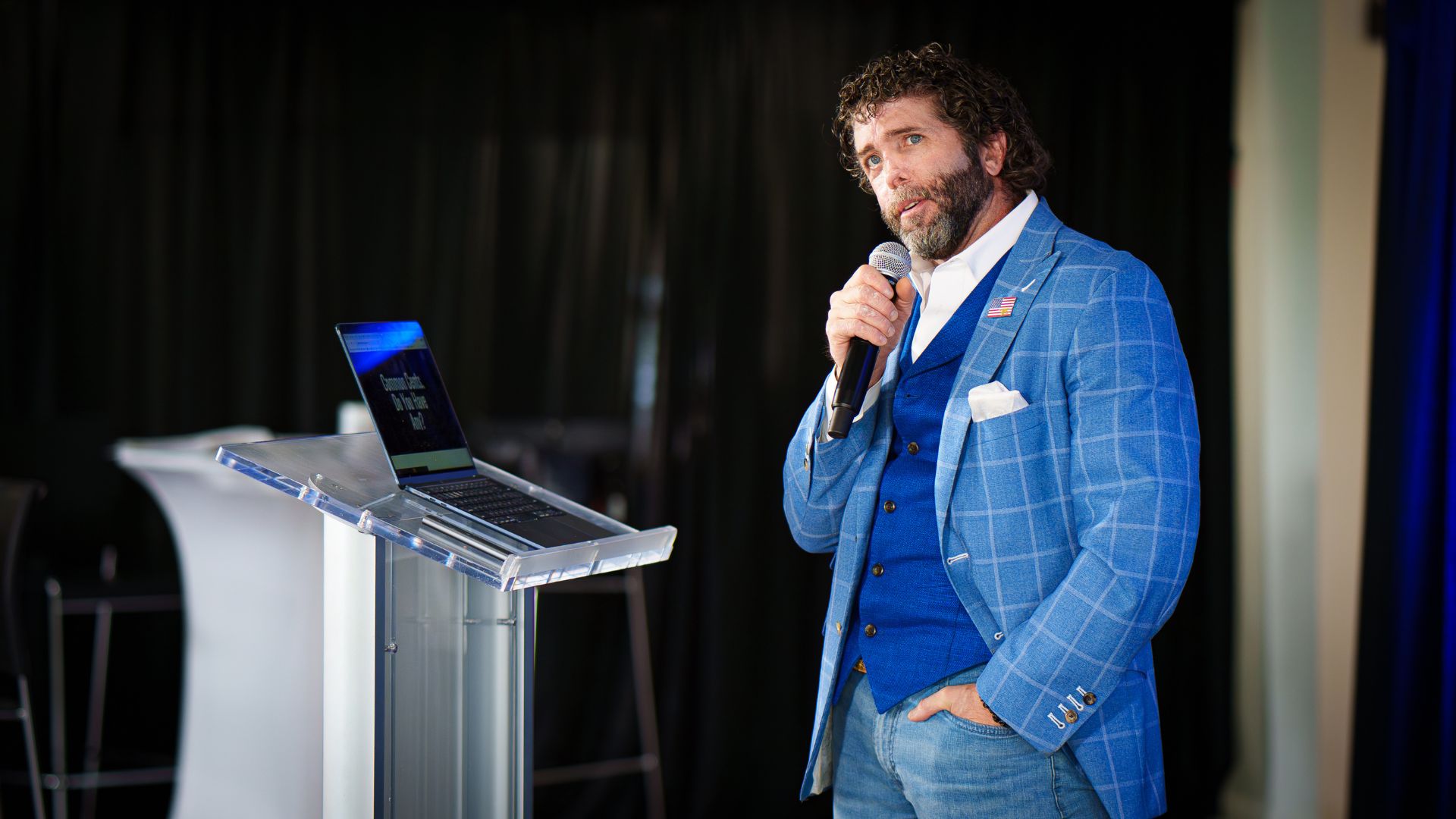When someone asks “what’s a motivational speaker cost?”, I tell them that’s like asking what a car costs. Could be $3,000, could be $300,000.
More than half of professional speakers raised their fees in 2025 compared to what they charged before. Event planners are noticing. The average keynote speaker at an in-person corporate event is around $15,500.
The motivational speaker cost question doesn’t have one answer because speakers aren’t interchangeable. A retired Navy SEAL charges differently than a business consultant. Someone who wrote a bestseller on leadership commands more than someone with 10,000 Instagram followers.
The Pricing Landscape (And Why It’s All Over the Map)
Speaker fees break down into recognizable patterns once you know what you’re looking at.
Starting around $2,500 to $5,000, you’ll find people breaking into professional speaking. They might be amazing at what they do – maybe they built a successful company or overcame something extraordinary – but they haven’t built a speaking career yet.
Often they’ve got day jobs. The fee at this level reflects that they’re still proving themselves, building testimonials, figuring out what works on stage.
What’s good about this tier? These speakers tend to be incredibly prepared because every gig matters to them. They’re not coasting on reputation. But, less experience means less certainty about how they’ll perform under pressure.
Move up to $5,000 to $10,000 and the mood completely changes. These speakers have done this enough times to know their material works. They’re getting solid reviews. Maybe they published a book, maybe they’ve got some credentials, maybe they’re just consistently good. They’re hungry to keep building momentum.
This range often delivers outsized value because speakers are still fighting to establish themselves as top-tier. They’ll customize more, show up earlier, stay later – whatever builds their reputation.
$10,000 to $20,000 speakers here have track records spanning years. They’ve probably written books that actually sold (not just printed). Many have earned certifications like CSP or built recognized authority in specific industries. Their presentations show the polish that only comes from repetition.
The reliability factor matters at this price point. These speakers have seen enough different audiences that they can adjust on the fly when something isn’t landing. They know how to recover from technical glitches. They’ve earned their fees through consistent performance over time.
Jump to $20,000 to $35,000 and we’re talking recognizable names within their industries. These speakers get booked a year or more out. They’ve been featured in major publications, maybe done TED talks, maybe consult for Fortune 500 companies. Just announcing their name boosts event registration.
Organizations paying this much are buying credibility by association. The speaker’s reputation validates the event itself.
$50,000 and up, sometimes way up. Former presidents. Olympic gold medalists. Famous business leaders everyone’s heard of. Are they better speakers than someone charging $20,000? Sometimes yes, often no. What they definitely bring is name recognition that sells tickets and generates buzz.

What Moves the Price Around
Two speakers at the same experience level might charge wildly different amounts for reasons that aren’t always obvious.
Reputation beats experience every time. Someone who’s been speaking professionally for 15 years but stayed relatively under the radar will charge less than someone who’s been doing it for 5 years but went viral with a TED talk or published a book that hit the bestseller list. The market doesn’t care about time served, it cares about demand.
Customization costs money, and it should. Some speakers show up and deliver basically the same talk they gave last week to a different audience. They’ll swap out a few references, maybe mention the company name a few times, but the core content doesn’t change.
Other speakers spend hours researching the organization, interviewing key people, reviewing strategic documents, and building something specifically for that audience. That preparation time is expensive. Organizations need to be honest with themselves about whether they actually want customization or if they’re fine with a great off-the-shelf presentation.
Geography is non-negotiable. Booking a speaker from across the country means flights, hotels, rental cars, meals, all of it. International speakers? Even more expensive. Business class flights aren’t cheap. Hotels in major cities during peak seasons aren’t cheap. These costs add up fast, often adding $2,000 to $5,000 on top of the speaking fee.
Some speakers live in major hub cities and are easier to route. Others are based in smaller markets and need connecting flights. It matters more than people think. One event planner mentioned they almost booked someone until they realized getting them to the venue required two connecting flights and an overnight stay each direction. The travel costs alone would’ve added $4,500.
Presentation length is weirdly irrelevant. Whether a keynote runs 45 minutes or 90 minutes usually doesn’t change the fee much. The speaker blocked that day, prepared the content, and traveled to the venue. The actual stage time becomes almost beside the point.
Multiple sessions are different. Asking for a keynote plus breakout workshops plus a leadership training session – that’s obviously more work and justifies higher fees. Many speakers offer package pricing for multiple sessions that works out better than booking each separately.
The Hidden Costs
Every experienced event planner has a story about budget surprises. The speaking fee is just where costs start.
Travel expenses get underestimated constantly. “We’ll just fly them in” sounds simple until it’s a peak travel weekend and flights are $1,800 instead of $600. Or the speaker needs to arrive the day before and leave the day after, which means two hotel nights at $300 each. Ground transportation, meals, parking – it accumulates faster than budgets account for.
Some speakers build reasonable travel into their quoted fee. Others itemize every expense separately. The difference can be significant, and organizations don’t always ask which approach they’re dealing with until it’s too late.
Technical requirements can spiral. Professional speakers often have specific AV needs. Particular microphone types, confidence monitors, certain lighting setups, specific presentation software. Most venues have basic equipment, but special requests mean rental fees. Some speakers travel with their own tech person, and yes, organizations typically cover those expenses too.
Video recording catches people off guard. If the speaker wants professional recording of their presentation (and many do), someone’s got to hire the video crew. That’s another $1,500 to $3,000 depending on the market.
Books and materials add up. Many speakers offer books, workbooks, or follow-up programs that extend impact beyond the presentation. Buying a book for each of 200 attendees? That’s several thousand dollars. Licensing access to their online course? More money. These extras often provide real value – personal accountability or learning to love yourself takes more than a 60-minute talk – but they’re still costs that need budgeting.
Cancellation policies protect speakers’ businesses. Professional speakers include contract terms about what happens if an event gets canceled or postponed. Usually there’s a non-refundable deposit plus graduated cancellation fees based on how much notice you give. These policies seem abstract until something forces a change and suddenly they’re very real.
Getting Value From the Money Spent
Start with actual objectives. “We want to inspire the team” isn’t specific enough. Inspire them to do what? Improve customer service scores? Embrace a new company direction? Take more initiative? Deal with change better? Specific goals let you pick the right speaker and measure whether it worked.
Metrics might include post-event survey responses, behavioral changes observed over the following weeks, productivity improvements, employee engagement scores. When speakers understand what success looks like, they can focus content on those specific outcomes.
Preparation matters more than most organizations realize. The work starts before the event. Share background information, current challenges, industry terminology, specific examples the speaker could reference. This context enables better customization and honestly just shows respect for the speaker’s craft.
Connect the speaker to other initiatives. Rolling out new leadership training? A motivational speaker whose message aligns with that training reinforces the concepts. Focusing on improving communication? An inspirational speaker addressing communication fundamentals multiplies the effectiveness.
Follow-through determines whether the money was worth it. The presentation is just the beginning. Organizations that facilitate post-event discussions, encourage teams to identify action items, and create accountability around implementation see dramatically better returns.
Some companies form small teams specifically to translate speaker insights into concrete action plans. Others schedule follow-up sessions where people report on what they’ve implemented. Without this structured follow-through, inspiration fades fast.

Other Options That Don’t Break the Bank
Not every situation needs a nationally known speaker. There are legitimate alternatives that deliver value while fitting tighter budgets.
Virtual events changed the game. Technology got good enough during recent years that virtual speaking actually works now. Interactive features, breakout rooms, live Q&A – when done well, virtual presentations engage audiences effectively. And without travel costs, virtual typically runs 50-70% less than in-person.
Hybrid models blend approaches. Maybe a virtual keynote followed by in-person breakouts with local facilitators. Or record a presentation for wider distribution while bringing the speaker on-site for smaller group interactions. Creative structures optimize budgets while maintaining quality.
Regional speakers offer surprising quality. Every area has accomplished speakers who might not be nationally known but deliver excellent presentations. Local business leaders, academic experts from nearby universities, successful entrepreneurs – they’re everywhere. They eliminate travel costs, usually charge less, and often bring particularly relevant local or industry insights.
These speakers frequently welcome opportunities that help build their portfolios. They might show pricing flexibility for organizations that provide strong testimonials, video recording opportunities, or connections to additional bookings.
Internal speakers can be incredibly powerful. Sometimes the most impactful presentations come from within the organization itself. A team member who overcame a huge challenge, achieved remarkable results, or embodies company values can connect with colleagues in ways external speakers never could.
Internal speakers don’t require fees, though supporting their development through confidence training or coaching improves their effectiveness. Organizations can identify people with compelling stories and help them craft presentations that land. This builds internal capability while creating speakers who genuinely understand the audience and organizational context, plus they can share the public speaking tips they’ve learned with others.
Bureau vs. Direct: Does It Matter?
Organizations book speakers two main ways, each with tradeoffs.
Speakers bureaus handle everything. These agencies maintain relationships with tons of speakers and match events with talent. They negotiate contracts, manage logistics, and solve problems. They know speakers’ pricing, availability, and fit inside and out.
Bureaus charge fees – either built into the speaker rate or separately. But for organizations without booking experience or needing speakers outside their network, that expertise often justifies the cost. Good bureaus also provide accountability, making sure speakers actually show up and deliver what was promised.
Direct booking sometimes saves money. Contacting speakers through their websites or agents can reduce costs by cutting out bureau fees. This works when you know exactly who you want and feel comfortable managing all the details yourself.
Direct relationships can enable more detailed customization conversations and easier communication throughout planning. But the organization takes on full responsibility for coordination, contracts, and problem-solving if anything goes sideways.
Making the Decision
Selecting a speaker deserves real thought. Organizations should evaluate fit with objectives, audience, and desired outcomes. Cheapest rarely means best value, but most expensive doesn’t guarantee success either.
Request demo videos of previous presentations. Watch how they engage audiences, deliver content, and command the stage. Read testimonials from organizations similar to yours. Discuss customization possibilities and gauge their genuine interest in understanding your specific situation.
Look at the complete package: presentation quality, professionalism, ease of working with their team, what else they bring.
A speaker charging a bit more but including pre-event consultation, customized materials, and follow-up resources might deliver better overall value than a cheaper option with just a basic presentation.
The investment should connect to larger goals – building team confidence, finding the right guidance, or creating momentum for change through powerful messages that stick.

Transform Your Organization With the Right Message
Understanding motivational speaker cost helps organizations make smart decisions that align budget reality with event goals. Options exist across the spectrum from emerging professionals at a few thousand dollars to celebrities commanding six figures.
Finding the right speaker whose expertise, message, and style fit your audience and objectives – that’s what actually matters.
Good budgeting accounts for hidden costs beyond the base fee. Maximizing return happens through strategic preparation and follow-through. View speaker investments as catalysts for meaningful change, not just event entertainment.
Jason Redman delivers messages built from extraordinary real-world experiences, combining military leadership insights with practical strategies for overcoming adversity and achieving excellence.
My presentations provide actionable frameworks that translate into measurable results for organizations needing to inspire teams, strengthen leadership, or drive meaningful change.


